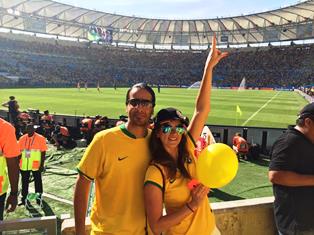
 Since it kicked off on June 12, the 2014 World Cup in Brazil has brought high energy to the field—and has scored progress on the green energy front as well. A case in point is the Mineirão stadium in Belo Horizonte, the first World Cup stadium powered by solar energy.
Since it kicked off on June 12, the 2014 World Cup in Brazil has brought high energy to the field—and has scored progress on the green energy front as well. A case in point is the Mineirão stadium in Belo Horizonte, the first World Cup stadium powered by solar energy.
The stadium’s 6,000 photovoltaic panels can produce 1,600 megawatt-hours per year (1.4 MW)—enough electricity for 1,200 households, according to the Brazilian federal government’s World Cup Portal. “As it’s not possible to store all the energy, 10 percent of it will be used in powering the Mineirão and the rest will be transferred to consumers,” said Alexandre Maia Bueno, a representative of the electric utility that built the facility’s solar plant. The Mineirão’s rooftop panels feed power directly into the grid.
Several other World Cup venues also have significant installed solar capacity, including the Mané Garrincha in Brasilia, the Itaipava in Pernambuco, and Rio de Janeiro’s legendary Maracanã. The largest sports stadium in South America, the Maracanã was refurbished for the World Cup and will also serve as a venue for the 2016 Olympic Games.
 In the lead-up to the World Cup, Brazil also invested in other sustainability measures. Mineirão was the first stadium in Brazil to earn a LEED platinum rating, the highest certification level under the standards for Leadership in Energy and Environmental Design. LEED is a voluntary system developed by the U.S. Green Building Council (USGBC) to promote strategies for sustainability in the building industry. Buildings are rated on a point system that includes such categories as sustainable sites, water efficiency, energy and atmosphere, materials and resources, indoor environmental quality, and innovation in design.
In the lead-up to the World Cup, Brazil also invested in other sustainability measures. Mineirão was the first stadium in Brazil to earn a LEED platinum rating, the highest certification level under the standards for Leadership in Energy and Environmental Design. LEED is a voluntary system developed by the U.S. Green Building Council (USGBC) to promote strategies for sustainability in the building industry. Buildings are rated on a point system that includes such categories as sustainable sites, water efficiency, energy and atmosphere, materials and resources, indoor environmental quality, and innovation in design.
Last year, the Castelão stadium in Fortaleza became the first of the World Cup venues to achieve LEED certification. Four others have since earned a silver rating: the Fonte Nova in Salvador, the Amazônia in Manaus, the Arena Multiuso in Recife, and the Maracanã. According to the USGBC, in terms of countries’ cumulative LEED-certified space, Brazil ranks seventh in the world (not counting the United States) on this environmental index—the only South American country in the top 10.
Brazil has also taken extensive steps to offset carbon emissions generated as a result of the World Cup, as has the sporting event’s organizing body, FIFA. The 2014 World Cup, which began with teams from 32 countries, comes to an end on July 13.
 View Map
View Map